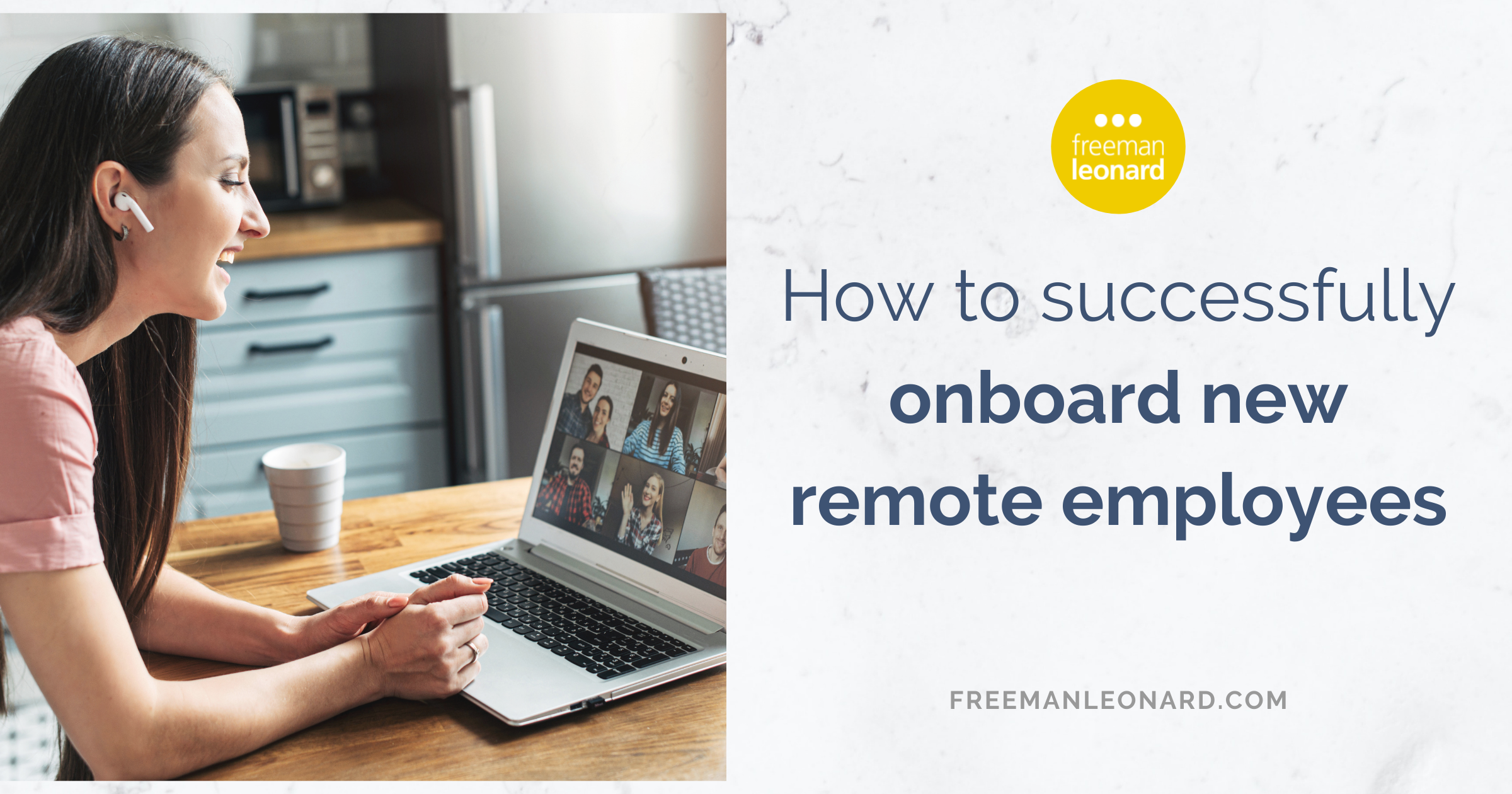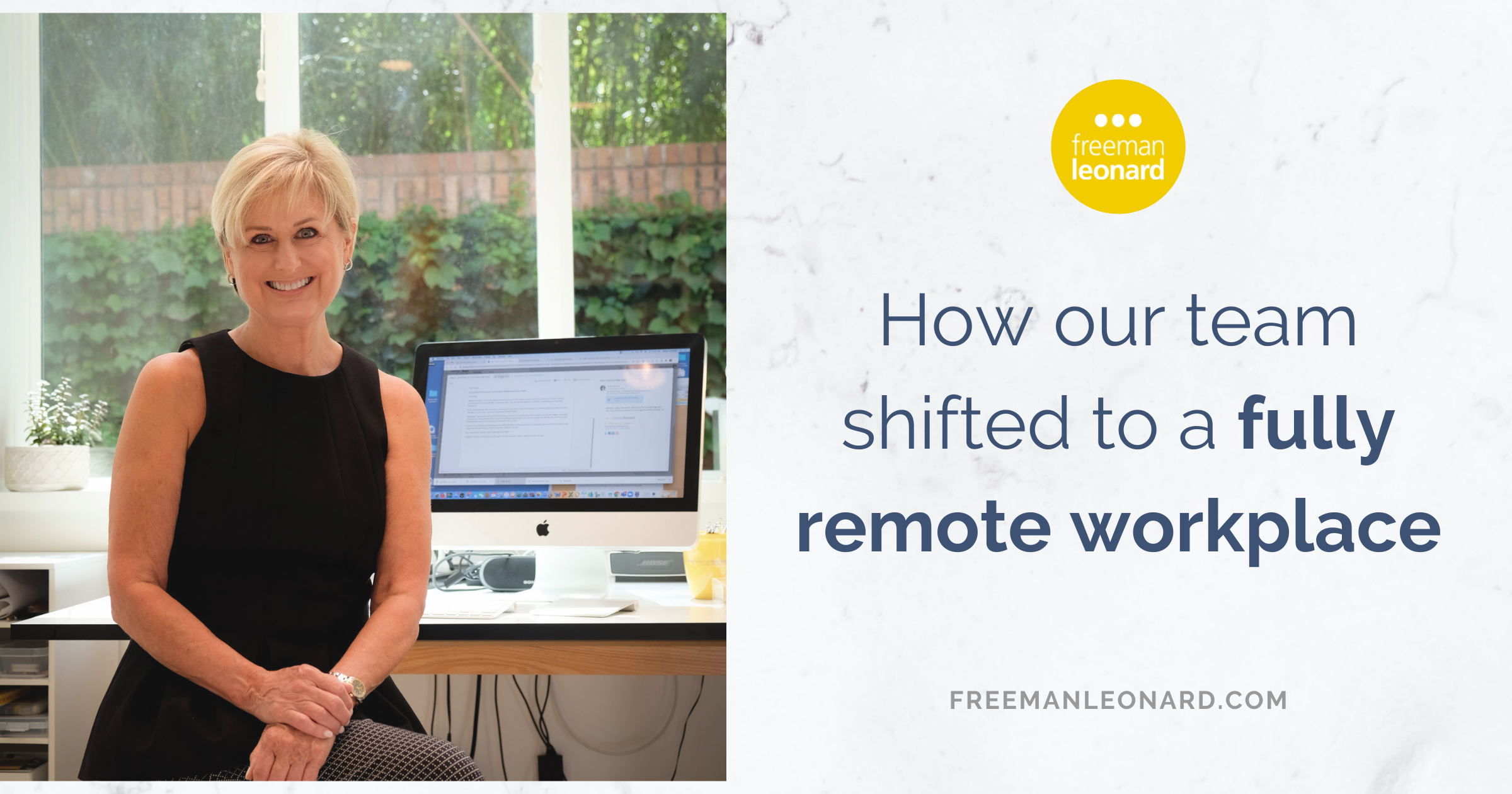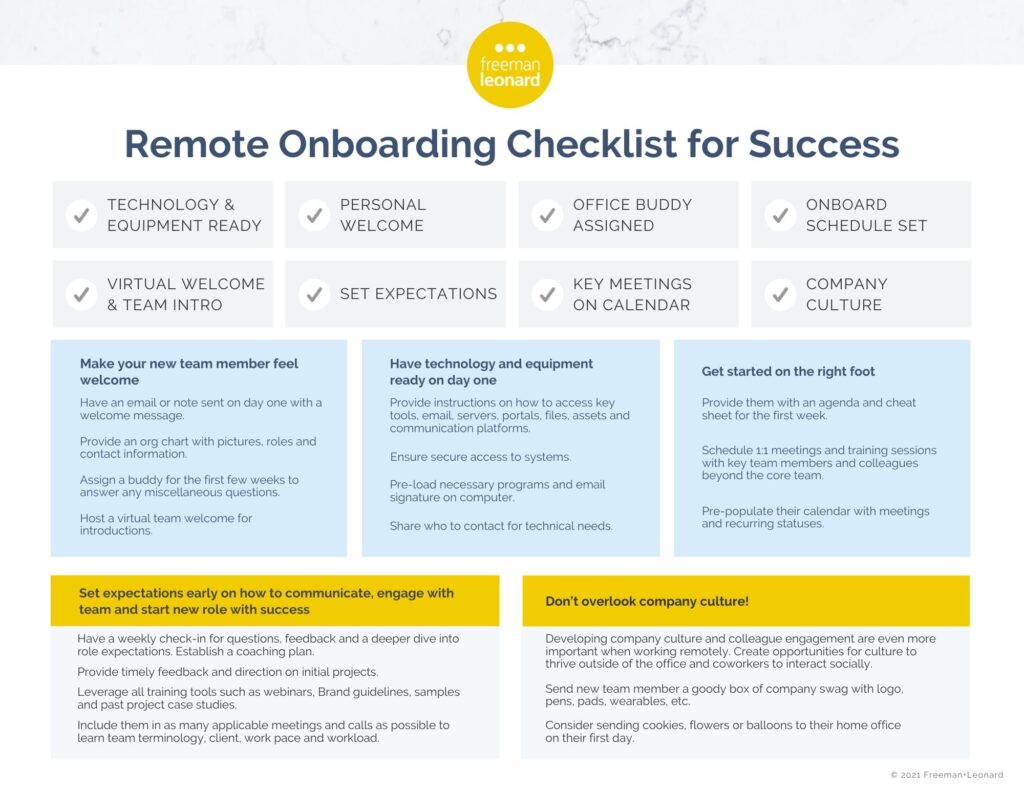How to successfully onboard new remote employees
How to successfully onboard new remote employees

First impressions are everything for a new employee joining your team. The experience your new team member has in their first few days can impact the rest of their time with your company.
“A good onboarding experience can make the difference between a candidate who leaves and one who stays,” explained Kathy Leonard, President & CMO of Freeman+Leonard.
But onboarding is much more than just the first day at work, with the equipment setup, the introductions, and so on.
“Onboarding is a broad term that really defines how a company pulls a new employee into their environment, their team and their culture,“ Leonard continued. “That's much more challenging in a remote world, obviously, than if you're physically there.”

“When onboarding remotely, you have to be more intentional about that first impression,” agreed Andrea Tipton, EVP, Marketing & Talent Solutions at Freeman+Leonard. “It takes more proactive planning to keep them excited about the role. It doesn’t matter what level you are; the onboarding experience makes a difference.”
Here’s how we’ve been advising our clients to set up their new remote hires for success:
Start communicating with your new hire before their first day.
Don’t wait until a new employee’s first day to begin the onboarding process — start sharing information and begin setting them up for success ahead of time.
“If a new hire doesn’t hear from their hiring manager until the day they’re starting, they can start to feel a little disconnected,” explained Andrea Campbell, Account Manager, Talent Solutions at Freeman+Leonard.
“Be in touch regularly on the front end,” agreed Lisa Foster, Sr. Director, Client Services at Freeman+Leonard. “Make sure they have everything they need before they start, and that their equipment is in place.”

Use this early communication to set expectations about their role and your remote work policies.
“Remote workers are expected to be more independent and organized, but not every new hire is used to that,” explained Campbell. “Start setting those expectations early, and consider helping them by providing organizational tools at home, like white boards.”
“Setting those expectations gets your new hire engaged faster, and the faster they’re engaged, the faster you’ll get results,” Tipton agreed.
Plan something special to welcome them on their first day.
Everyone enjoys feeling appreciated and celebrated, and planning a surprise will help your new employee start their first day off on the right foot.
“Consider sending a welcome gift to your new employee’s home on their first day to help them feel more included,” advised Campbell.
“Send flowers on the first day,” Tipton suggested, “or goodies that everyone loves, like Tiff’s Treats.”
Map out their first week in advance.
To ensure your new employee has a good experience, don’t leave their schedule to chance. Structure is helpful, especially for those trying to get a grasp of their new role while working from home.
“We like to have a new hire’s entire first week mapped out, to the hour, including who they’re meeting with, and even who they’re having lunch with each day, if they’re not fully remote,” explained Tipton.
“Just make sure you have a plan,” Tipton continued. “Day one can be a little crazy, so you don’t want to wing it.”
Schedule time to get to know new teammates.
Getting to know new coworkers can be a little more difficult for a new remote employee, so help them jump-start the process.
“You want your new employees to feel like they've joined a team and are being embraced into a new culture — and to see that everybody is really excited and happy they’re there,” Tipton advised.
“Give them a cheat sheet with photos, titles and contact info for their coworkers,” Tipton continued. “And assign them a buddy, so they have a peer to turn to for questions; not just their boss, who they may not want to bother with the small stuff.”
If you can, meet in person for a team lunch or happy hour.
“If an in-person meet-and-greet is a possibility, pencil-in a team happy hour or lunch for their first day or week so they have the opportunity to meet folks face-to-face,” said Foster.
“You could even meet in person to hand off their computer,” Lisa continued.
If not, “Schedule in a virtual happy hour so that everyone can get to know the new person a little better,” suggested Rosemary Salfiti, VP, Client Services at Freeman+Leonard..
Provide training on new systems and tools.
Every new job comes with new technology and processes to learn. Fortunately, training someone remotely is easier than ever.
“With Zoom, everyone’s so used to screen sharing that it’s just as easy to be onboarded remotely as it is in person,” Campbell said.
“It can actually be more informative, because you see everything right on your own screen,” Andrea continued, “versus just being in the room with someone and having to look over their shoulder.”
Record your Zoom training sessions so new employees can go back and watch again, and document your processes with quick tutorials.
“Having something to reference can help people learn a new system faster and make fewer mistakes,” Andrea Campbell explained. “It doesn’t have to be anything fancy, just a quick screen grab with a little note.”
Make yourself available and schedule frequent check-ins.
Even with a buddy system and team introductions, it’s easy for remote workers to feel more isolated than they would in an office setting. New employees want interaction with the person who hired them, especially if they’re more junior.
“60% of the Gen Z workforce wants multiple check-ins per week from their boss,” Foster explained. “They really want that connection, for someone to check in on them.”
“It can be hard to get the mentorship you’re looking for when you’re by yourself all the time,” Salfiti added.
More than anything, Tipton advised, “Don’t forget that they’re new, and don’t forget to include them.”

“I’m a fan of what I like to call the ‘long hallways’ approach,” Tipton said. “You may not be sitting in the same building together, but you have to make it feel like you are.”
“If you want a new hire to integrate nicely, you have to make yourself available,” Tipton continued. “If you’re too busy to onboard them, you’re going to lose them. And then you’ll be right back where you were, trying to find someone else to replace them.”
Are you building a remote or hybrid team?
Grab our new Remote Onboarding Checklist to get all of these tips in a printable 1-page PDF.
Click on the image to view and download the PDF:
How our team shifted to a fully remote workplace
How our team shifted to a fully remote workplace

As the world returns to something resembling normalcy and workplaces reopen, many companies and their employees are realizing that we have an opportunity to rethink the status quo — and reimagine the future of work.
For all of us at Freeman+Leonard, that has meant embracing some of the changes that enabled us to succeed during the pandemic, despite incredible upheaval.
Though working from home seemed like a temporary solution, we recently decided to make it permanent.
When our 15+ year lease in an office tower near the Galleria in Dallas drew near its end, we decided not only to not renew it, but to not seek out a new space.
After all, why would we? Sales are up. Productivity is up. Morale is up. And there’s very little we can’t do from an internet connection and a laptop.
“The interesting thing for our team is they’d have negotiated for work-from-home days over vacation days,” said Kathy Leonard, President and CMO of Freeman+Leonard. “And even the talent we place are often willing to take less base pay for the ability to work from home.”
The benefits for employees are clear. “The flexibility and money saved from not having to commute, from lunches out to work clothes to the wear and tear on your car, are a big plus — but it also just makes people more efficient,” Kathy continued.
And that efficiency is translating to more output for the business, not less.
“Our productivity is at an all-time high because we enjoy working from home and having that more flexible lifestyle. And the reduced expenses and lower overhead contribute to higher profitability,” Kathy shared.
The writing was on the wall: The future of work is here, and for Freeman+Leonard, it doesn’t include walls. At least not cubicle walls.
With that, we left in the dust our old way of working, and haven’t looked back.
One year later, we’ve learned a lot about how to succeed with remote work. Though the shift is a strong net-positive and a no-brainer for our team, that doesn’t mean it’s been without its challenges.
Here are the lessons we’ve learned over the past year about how to successfully operate in a permanently remote or hybrid work environment.
Establish new ways to measure team productivity.
“Performance can be tracked in any number of ways outside of traditional hours,” shared Kathy.
“Ideally, you have clear expectations for your team and the objectives they’ve been hired to accomplish for your business — so each employee knows they’re measured against a certain key performance indicator.
“Everything’s digital now, and that allows you much more visibility of the metrics of your business, even ones that are further upstream. For a sales team, you can track the number of phone calls they’re making to potential clients, or new contacts they’re entering into our database. For our recruiters, we can track the number of interviews they’ve scheduled.
“The time spent on these activities does not always directly translate to productivity levels, so there’s no need to micromanage or require a certain number of hours to be spent in an office.”
Approach virtual meetings with more discipline and strategic planning.
In a remote or hybrid workplace, collaboration becomes less happenstance. Without the hallway conversations or opportunity to swing by a colleague’s desk, virtual meetings are more crucial than ever. Webcams and Zoom become critical tools for sharing information, generating ideas and making decisions.
But people might behave differently in virtual meetings than they do in person. Even on a video call, and even with good intentions, it’s easy to hide behind a screen.
“You have to plan intentionally to ensure people treat Zoom meetings like the real meeting,” said Andrea Tipton, EVP, Marketing & Talent Solutions at Freeman+Leonard. “Set clear expectations for each meeting about what each participant’s role will be.”

For example, will everyone be expected to contribute, or are certain attendees there only to receive information? Putting these expectations and an agenda directly in the meeting planner is ideal for ensuring everyone will be aligned on our objective and has the opportunity to prepare.
When conducting the meeting, stay on-task to keep the meeting productive. Call on certain individuals to make sure everyone has the chance to contribute, and end each call with clear next steps.
And know when something shouldn’t be a virtual meeting.
Though a lot of collaboration can happen remotely, sometimes there’s just no substitute for real face time.
“Our team decided early on that, as soon as we felt comfortable, we’d commit to having certain strategic and collaborative meetings in person,” Andrea shared. “Membership at a coworking space gives us the option to book conference rooms for quarterly planning meetings and other brainstorms that truly benefit from being in person.”
But have fun with it!
Without seeing each other in person every day, a little more effort is needed to stay connected and keep your culture alive. So, Andrea advocates building in those fun elements and recognition.
“Before, it was fun to come in and find surprises from co-workers, like balloons all over your cube for your birthday,” Andrea said. “So instead, we would have fun deliveries like goodie bags, Tiff’s Treats, awards or even surprise drive-by visits.”
Now that in-person interaction is back, our team has also returned to having happy hours and lunches together, but we still find ways to build in small surprises even while working virtually.
“We’ll still send cards and treats to our team’s homes, or put on crazy Zoom backgrounds or dress up for video calls on each other’s birthdays. We can’t go more than six or seven weeks without something fun,” Andrea said.
Recognize employees early and often, even for the small stuff.
Even before the pandemic, Andrea sent out Friday emails with a note of recognition for employees — a weekly kudos to members of the team who did something notable or appreciated.
During lockdown, this tradition became a key part of maintaining morale, and it’s now a permanent part of the Freeman+Leonard company culture.
“My favorite kind of kudos to include is when I get an email or communication from talent or a client praising one of our team members, and they may not even know this was said about them. Or, it could be for something they did quietly, and weren’t aware I even knew about.”

Kudos can also be simple notes of appreciation for the way a colleague helped out. “It’s a small token, but it can be motivating,” Andrea said. “It means a lot to know that small things still get noticed, even though no one’s sitting next to you.”
Andrea has a tip for managers who want to implement this practice on their teams.
“Every Monday, I start a draft email called “Kudos” and add to it throughout the week. I don’t want to forget anything and have to try to remember it all on Friday morning. So as the week goes on, when something exciting happens or there’s something I want to highlight, I just open up the draft and add it there.”
Foster a culture of transparency from the top, down.
Just as it’s easy to hide behind a laptop in a remote environment, the lack of direct contact can easily lead indirectly to less information sharing.
It’s critical, then, that leaders promote a culture of openness, candor and transparency — including proactive conflict resolution.
“Effective one-on-one communication can suffer when you don’t do as much of it,” Kathy said. “Sometimes you need to get some of that conflict out on the table so you can address it.”
Upgrade your tech — and organize your files.
“One of the first things we did when we transitioned to remote work was reorganize our files to make everything easier to find,” Andrea said. “We revamped our entire portal and filing system and committed to having as much as possible in digital form.”
With fewer sponsored events — like Social Media Breakfast Dallas (now Digital Marketing Dallas), which Freeman+Leonard hosted and sponsored for several years — the team had less need for paper, anyway.
“We’re not distributing as many hard copies as we are digital copies of marketing materials,” Kathy said. “Digital is easy to share and inexpensive to produce.”
In addition to Zoom and Microsoft Teams subscriptions, we also invested in more-secure ways to share files and information, and upgraded existing systems to get more out of the tools we already had.
“We added Cloud Call to our CRM, which puts all of our data about client or talent contacts at our fingertips,” Andrea said. “Now when I’m talking to someone, my note screen automatically comes up with that contact’s entire profile in front of me. Being connected immediately with their most recent information helps us all be more efficient.”
Help your team enforce boundaries.
“A downside of everyone working remotely now is that clients and talent expect you to be available all the time,” says Rachel Runnels, Director, Talent Solutions at Freeman+Leonard, who had already worked from home for several years before the pandemic. “You can’t just shut it off.”
“The pros far outweigh the cons, but the biggest challenge is turning it off,” agreed Lisa Foster, Sr. Director, Client Services at Freeman+Leonard. “Now that I’ve set up a complete office, it’s really tempting to walk back in after I’m supposed to be done for the day. Before, I had to pull out my laptop, and it felt more compartmentalized.”
If you’ve hired self-motivated workers, in a remote work environment your greater responsibility as a manager may actually lie in helping your team enforce work-life boundaries, more than policing their productivity, advised Kathy.
“Be sure your team knows that a reply isn’t expected at all hours, and that they can shut it off.”
Hire self-motivated, career-minded workers with strong communication skills.
“Success with remote or hybrid work starts with the right kind of hire,” Kathy said. “You have to hire self-motivated, career-minded people to make this work.”
Good verbal communicators are also more likely to succeed in remote workplaces, where the nuance of body language and facial expressions are often lost in a flurry of text messages, Slacks, emails and voice chats. But thankfully, this already comes naturally to many marketers.

Armed with a clear understanding of their role and expected outcomes, entrepreneurially minded employees will thrive with the flexibility offered by working from home.
“We’re highly efficient and we’re actually having a killer year,” Rachel said. “So it goes to show that it can work.”
Looking for self-motivated new hires for your newly remote marketing team or agency?
Use the contact form below to reach out and start a conversation. It costs nothing to explore your options.
Get in touch with a Freeman+Leonard consultant today:






